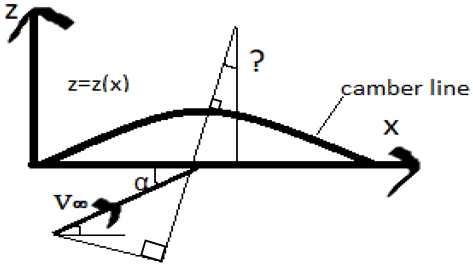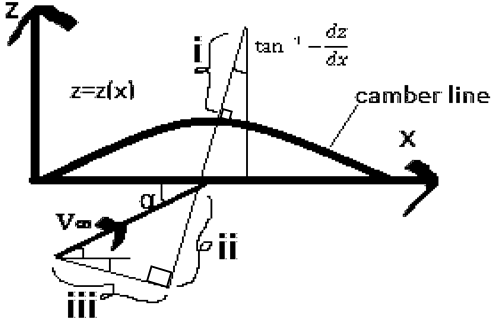This set of Aerodynamics Multiple Choice Questions & Answers (MCQs) focuses on “The Symmetric Airfoil – 2”.
1. A vortex sheet placed along the chord line gives the best representation for______
a) Thick Airfoil
b) NACA Airfoils
c) Negatively Cambered Airfoil
d) Thin Airfoil
View Answer
Explanation: Thin airfoils can be simulated as a vortex sheet kept along the camber line. Thick airfoils cannot be represented like this. Negatively cambered airfoils may or may not be thin and in that case, this representation might be incorrect. NACA airfoils have all types of airfoils, not thin airfoils only.
2. What is the Kutta Condition in terms of strength (γ) of the thin airfoil?
a) γ = 0
b) γ(LE) = 0
c) \(\frac {D\gamma }{Dt}\)=0
d) γ(TE) = 0
View Answer
Explanation: According to the Kutta condition, the condition for flow leaving smoothly is satisfied always by γ(TE) = 0. The other options may not be true as per the Kutta Condition.
3. Given the component of free-stream velocity in the direction perpendicular to the camber line is 15 units and the velocity induced by the vortex sheet is 4 units at a point. The angle of attack for the thin airfoil is α. Then which of the following condition is true in case of thin airfoil theory?
a) 15sinα+4=0
b) 15+4=0
c) 15cosα+4=0
d) 15tanα-4=0
View Answer
Explanation: In thin airfoil theory, the camber line has to be a streamline. Thus, the component of velocity in the normal direction to the camber line is zero at any given point. This means the sum of velocity components by the free stream velocity and the induced velocity is zero.
4. The thin airfoil theory assumes the vortex sheet is kept along the chord line and the camber line acts as a__________
a) Streamline
b) Vortex Filament
c) Another Vortex Sheet
d) Dividing Streamline
View Answer
Explanation: For thin airfoils, camber and chord lines are very close and the vortex sheet can be assumed to be placed at the chord line. And the camber line becomes a streamline.
5. Identify the missing angle given by the question mark for the following camber distribution of a thin airfoil.

a) tan-1α
b) tan-1-\(\frac {dz}{dx}\)
c) tan-1\(\frac {dz}{dx}\)
d) tan-1–\(\frac {dz}{dx}\)+α
View Answer
Explanation: For a camber distribution where z=z(x), at a given point on the camber line the missing angle is the slope at that point, which is tan-1-\(\frac {dz}{dx}\) which is independent of α.
6. Find the induced velocity in the direction normal to the camber line a point on where the slope is 0.087. Given the angle of attack is 5° and free-stream velocity is 20 units. Use thin airfoil approximation.
a) 0
b) 101.74 units
c) 98.26 units
d) 3.48 units
View Answer
Explanation: For a thin airfoil, the sum of free stream velocity component (V∞) and the induced velocity normal to the camber line is zero. And for small angles, V∞n ≈ V∞(α-\(\frac {dz}{dx}\)) where α is the angle of attack in radians and \(\frac {dz}{dx}\) is the slope at that point. Solving, V∞n ≈ 20(0.087-0.087), this is equal to the induced velocity.
7. Which is the component of free-stream velocity normal to the camber line for the given thin airfoil?

a) i
b) iii
c) ii
d) V∞
View Answer
Explanation: V∞ is the free-stream velocity. Here i is not a component of free-stream velocity, iii is the parallel component and ii is the normal component for the camber line.
8. The following equation is known as_________
Equation: \(\frac {1}{2\pi }\int_0^c \frac {\gamma (\xi)d\xi }{(x-\xi)}\)=V∞(α-\(\frac {dz}{dx}\))
(Where c is the chord length for a thin airfoil, α is the angle of attack, V∞ is the free-stream velocity, \(\frac {dz}{dx}\) is the slope at point x and γ(x) is the vortex strength at x).
a) Airfoil equation
b) The fundamental equation for airfoils
c) The fundamental equation for symmetric airfoils
d) The fundamental equation for thin airfoil theory
View Answer
Explanation: The given equation is called the fundamental equation of thin airfoil theory. The RHS is the component of free-stream velocity normal to the camber line. The LHS is the negative of the induced velocity normal to the camber line. The equation says the camber line acts as a streamline of the flow.
9. The fundamental equation for the thin airfoil theory does not encompass which of the following approximations?
a) The angle of attack and slope of the camber line is small
b) Camber line induced velocity distribution is the same for chord line
c) Vortex sheet is placed at the chord line
d) Kutta condition is satisfied at the trailing edge
View Answer
Explanation: Kutta condition is always satisfied at the trailing edge. This is the boundary condition for the camber line to be a streamline also and is not an approximation. While the other three statements are valid approximations, which have been made under the assumption of a thin airfoil where camber and chord line is very close.
10. Identify ‘a’ as shown in the figure for a thin airfoil.

a) Camber
b) Chord Line
c) Camber and Chord Line
d) Neither Chord Line neither Camber
View Answer
Explanation: For a symmetric airfoil(\(\frac {dz}{dx}\)=0), camber line is the same as chord line. Therefore, the best option is Camber and Chord Line. Only Camber or Chord Line is an incomplete answer.
11. The value of integral ∫\(_0^?\frac {cosn\theta d\theta }{cos\theta-cos∅}\)=π\(\frac {sin n∅}{sin ∅}\) is valid for the limit 0 to_____
a) π
b) 2π
c) –π
d) nπ
View Answer
Explanation: This is a standard integral which is used many times in the study of airfoils. This is used to solve the transformed fundamental equation in thin airfoil theory where the chord length is expressed as θ=0 to θ=π.
12. The Kutta Condition according to the thin airfoil theory is_____
a) γ(c)=0
b) γ(x)=0
c) γ(ξ )=0
d) \(\frac {dz}{dx}\)=0
View Answer
Explanation: The Kutta Condition says the flow leaves the trailing edge smoothly. The trailing edge is at chord length c for a thin airfoil which gives γ(c)=0. Also, γ(x)=0 or γ(ξ)=0 is not true for all x or ξ. \(\frac {dz}{dx}\)=0 is the definition of the symmetric airfoil, not Kutta condition.
13. Which of the following is not correct for symmetric airfoil according to the fundamental equation of thin airfoil in transformed coordinates?
a) 0≤θ≤π
b) \(\frac {dz}{dx}\)=0
c) ξ=\(\frac {c}{2}\)(1-cosθ)
d) γ(θ)=0
View Answer
Explanation: The transformation for thin airfoil theory uses ξ=\(\frac {c}{2}\)(1-cosθ) to make the coordinate transformation, where 0≤θ≤π. For a symmetrical airfoil (\(\frac {dz}{dx}\)=0), while γ(θ)=0 is not true for all values of θ.
Sanfoundry Global Education & Learning Series – Aerodynamics.
To practice all areas of Aerodynamics, here is complete set of 1000+ Multiple Choice Questions and Answers.
If you find a mistake in question / option / answer, kindly take a screenshot and email to [email protected]
- Practice Aeronautical Engineering MCQs
- Check Aeronautical Engineering Books
- Apply for Aerospace Engineering Internship
- Practice Aerospace Engineering MCQs
- Check Aerospace Engineering Books
